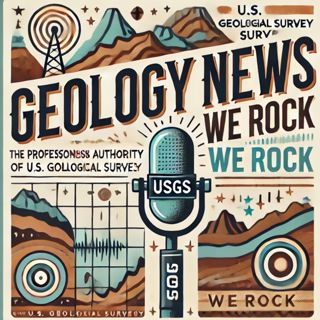
U.S. Geological Survey Unveils Critical Minerals List and Oil/Gas Assessments, Highlighting Pivotal Developments in Geology
In the United States, geology news this week has been marked by several major developments shaping both resource management and scientific understanding. The U.S. Geological Survey, under the Department of the Interior, has just released the draft 2025 List of Critical Minerals and a new report outlining an updated methodology for identifying minerals whose supply chain disruptions could impact the national economy. This new approach would increase the number of minerals on the critical list to fifty-four, reflecting significant reassessment of global supply risks and direct investment strategies for mining and resource recovery. The revised list is poised to influence government policy, infrastructure investment, and industry efforts across the United States, as mineral supply security grows more vital with technological advancement and energy transition, as reported by the U.S. Geological Survey.Resource assessments continue to play a central role in geology-related news. In the last few days, the U.S. Geological Survey released new estimates for oil and gas potential in the Phosphoria Total Petroleum System and the Niobrara Formation, covering southwest Wyoming and northwest Colorado. These regions together hold the potential for more than 700 million barrels of oil and over 6 trillion cubic feet of natural gas, underscoring the importance of ongoing geological surveys in ensuring future energy supplies for the United States.Recent events also highlight the effects of geological phenomena on society. In Phoenix, Arizona, a towering dust storm known as a haboob swept through the city, driven by gust-front winds and plunging the region into sudden darkness. The event, featured in The Washington Post, demonstrates seasonal dust dynamics in the Southwest and their link to broader desert geology and weather patterns.Worldwide, geology remains a focus of both research and immediate concern. According to Volcano Discovery, the largest global earthquake in August registered as magnitude six point eight off Severo-Kurilsk, Russia, while other significant quakes have affected West Papua, Indonesia, and parts of Central Asia. These events point toward ongoing seismic risks and the importance of geological monitoring worldwide.On the research and scientific front, experts recently convened at IGARSS 2025 in Brisbane, Australia, and at the International Symposium on Antarctic Earth Sciences in Punta Arenas, Chile. Both events feature groundbreaking presentations on remote sensing, tectonics, ice sheet dynamics, and the global Earth system. Notably, ScienceDaily reports the discovery of three hundred thirty-two colossal submarine canyons hidden beneath Antarctic ice, a finding likely to impact how geologists understand glacial forces and the deep structure of polar environments.Altogether, recent developments indicate continued evolution in geological science, strategic resource management, and the adaptation to natural hazards, with the United States maintaining a central leadership role in advancing global geology-related efforts.Some great Deals https://amzn.to/49SJ3QsFor more check out http://www.quietplease.aiThis content was created in partnership and with the help of Artificial Intelligence AI
27 Aug 3min

Striking U.S. Geological Discoveries Unveil Vast Energy Resources and Changing Landscapes
Scientists in the United States have made significant geological discoveries this week, with the U.S. Geological Survey releasing major new assessments of oil and gas resources in the Rocky Mountain region. According to findings published by the USGS, the Niobrara Formation, spanning southwestern Wyoming and northwestern Colorado, is now estimated to contain 703 million barrels of oil and 5.8 trillion cubic feet of natural gas. Similarly, the Phosphoria Total Petroleum System in the same region could yield about 666 billion cubic feet of gas and more than three million barrels of oil. These discoveries highlight the region’s ongoing importance to U.S. energy supplies, and officials point out that such assessments are crucial both for resource management and for evaluating the environmental impact of future exploration.In Alaska, the USGS also responded to glacial flooding near Juneau. These flood events, known as glacial outburst floods, have become increasingly common and are closely monitored due to their impact on infrastructure and local communities. Glaciologists are closely studying these events to better predict future flooding scenarios as climate change accelerates glacier melt, potentially leading to increased flood risk in Alaska and other high-latitude regions across North America.Hawaii’s Kīlauea volcano continues to produce headlines as well. The USGS Hawaiian Volcano Observatory, during a helicopter survey on August 5, observed a lava pond within the north vent at the Kīlauea summit. This pond is feeding a subterranean lava tube toward the Halema‘uma‘u crater floor. The geologists indicate that recent activity mirrors signs that preceded earlier eruptive episodes since December 2024 and anticipate that new eruptive activity is imminent. Observers are paying close attention to any changes that could pose a hazard to surrounding communities, given Kīlauea’s history as one of the world’s most active volcanoes.The geology community from around the globe is also gathering in the U.S. this August. The Society of Geology Applied to Mineral Deposits is holding its biennial meeting in Golden, Colorado, celebrating its sixtieth anniversary. Researchers and industry partners are convening to discuss the latest findings on mineral deposits, resource exploration, and environmentally responsible extraction techniques. Golden sits at the gateway to the Rocky Mountains, an area renowned for its rich deposits of gold, molybdenum, and rare earth elements, setting an appropriate backdrop for discussions about the future of critical minerals.Meanwhile, major international events continue to shape the field of geology. For example, mapping efforts in Antarctica have just uncovered more than three hundred colossal underwater canyons beneath the ice, reshaping scientists’ understanding of glacial activity and past climate patterns. These findings, while not U.S.-based, are influencing research priorities globally as geologists seek to unravel how such structures impact the planet’s changing climate. Overall, the recent developments in U.S. geology focus strongly on resource assessments, hazards monitoring, and international scientific collaboration.Some great Deals https://amzn.to/49SJ3QsFor more check out http://www.quietplease.aiThis content was created in partnership and with the help of Artificial Intelligence AI
23 Aug 3min

"Volcanic Eruptions, Seismic Activity, and Geoscience Innovations Dominate the US Geological Landscape"
Geological activity across the United States over the past week has centered on both volcanic and seismic phenomena, along with important developments in applied geoscience. The U.S. Geological Survey has provided regular updates on the ongoing Halemaʻumaʻu eruption at Hawaii’s Kilauea volcano, where the current phase began in late June. Recent field and overflight observations confirm vigorous lava fountains continue from the north vent, while persistent volcanic glow and seismic tremor indicate that magma remains close to the surface. Imagery from August has shown new lava flows now covering nearly eighty percent of the Halema‘uma‘u crater floor, reshaping the landscape in real time. These episodes are tracked closely by local and federal observatories as the event remains dynamic and visually remarkable.Meanwhile, in the Cascade Range of the Pacific Northwest, which includes Mount Rainier, Mount St. Helens, and Mount Hood, all monitored volcanoes are currently at normal activity levels. Despite this, minor earthquakes have been recorded at several of these peaks over the past week, reminding researchers of the persistent geologic unrest inherent in the region. Field crews have been conducting routine maintenance and hydrological studies to strengthen monitoring capabilities, ensuring any changes are quickly detected.Looking beyond volcanic activity, attention is also shifting to geoscience innovations. The upcoming International Meeting for Applied Geoscience and Energy, known as IMAGE, is set to take place in Houston from August twenty-fifth to twenty-eighth. This event brings together earth scientists and energy professionals to discuss advancements in exploration, data analysis, and sustainability, emphasizing the evolving role of geologists in meeting future energy and environmental demands.Internationally, geologists continue to uncover significant new insights. Caltech researchers analyzing the massive Myanmar earthquake from March twenty twenty-five have found that strike-slip faults can exhibit surprisingly complex behaviors, changing how scientists assess risk along similar faults. Another major discovery was made in Antarctica, where scientists using advanced underwater mapping revealed an extensive network of three hundred thirty-two colossal submarine canyons hidden beneath the ice. These features could play a vital role in global climate and ocean circulation.Finally, Arctic geological sample expeditions have just begun, aiming to reconstruct climate shifts by examining sediments and rocks from the distant past. These U.S. and international efforts underscore a pattern of heightened attention to understanding both immediate geologic hazards and long-term planetary processes. In sum, the past week has showcased an active landscape for geology, from dramatic volcanoes in Hawaii and watchful stability in the Cascades, to innovative forums in Houston, and landmark findings shaping the future understanding of Earth’s dynamic system.Some great Deals https://amzn.to/49SJ3QsFor more check out http://www.quietplease.aiThis content was created in partnership and with the help of Artificial Intelligence AI
20 Aug 2min

Kīlauea Volcano Eruption Sparks Geologic Investigations, Upcoming Conferences Highlight Mineral Exploration and Antarctic Discoveries
In the past week, the geologic community in the United States has been actively engaged with several major developments, both domestic and international. According to the United States Geological Survey, a significant episode at Kīlauea volcano in Hawai‘i has prompted field investigations after the latest fissure eruption in Halemaʻumaʻu crater ended abruptly on August 6. Scientists sampled spatter from the new fissure on August 13 to study the physical and chemical properties of the erupted material and deepen the understanding of the volcano’s magma storage conditions. Although Kīlauea is not currently erupting, July and August have seen intermittent activity, with a notable lava pond observed in the north vent earlier this month, feeding tubes toward the crater floor. Such field observations are crucial, as similar precursory behavior has led up to past eruption episodes, highlighting Kīlauea’s continued status as one of the world’s most closely monitored and actively studied volcanoes.On the mainland, preparations are underway in Golden, Colorado, for the 18th Biennial Meeting of the Society of Geology Applied to Mineral Deposits from August 3 to 7. This conference marks the Society’s 60th anniversary and brings together geologists, researchers, and students to present new research related to mineral exploration, development, and environmental impact. Golden, historically an important mining hub and the site of the Colorado School of Mines, gives scientists unique access to notable mineral districts in the Rockies, including areas rich in gold, silver, lithium, and rare earth elements. This gathering underscores the importance of geological research for modern resource management and sustainable development.Internationally, geological attention has turned to tectonic events with global implications. The United States Geological Survey recorded a magnitude eight point eight earthquake off the Kamchatka Peninsula in Russia on July 29. This was the largest earthquake worldwide since the nine point zero magnitude Tohoku event in Japan in 2011. Shallow reverse faulting along the Kuril-Kamchatka subduction zone triggered the quake, and more than fifty magnitude five or greater tremors, including a magnitude seven point four forequake, preceded it. This sequence is considered a reminder of the complex and dynamic interactions at plate boundaries, which directly impact the broader North American plate system, including Alaska.Researchers are also looking southward, as attention shifts to internationally significant meetings like the upcoming International Symposium on Antarctic Earth Sciences in Chile, August 18 to 22. There, U.S. scientists will collaborate with peers worldwide to discuss Antarctic geology, ice sheet-climate dynamics, and related ecosystem changes. Meanwhile, major submarine canyons have just been mapped beneath Antarctic ice, revealing a hidden network whose origins trace back to ancient glaciers, according to ScienceDaily. These discoveries emphasize the far-reaching importance of Earth science in understanding both hazards and resources, as well as the interconnectedness of the global geological system.Some great Deals https://amzn.to/49SJ3QsFor more check out http://www.quietplease.aiThis content was created in partnership and with the help of Artificial Intelligence AI
16 Aug 3min

Untapped Treasures: USGS Uncovers Massive Domestic Energy Reserves in the Rockies
In the past week, geology has been in the spotlight across the United States, with updates from the United States Geological Survey indicating both ongoing research and emerging trends. Most notably, the USGS released new assessments of undiscovered oil and gas resources in southwestern Wyoming and northwestern Colorado. Their studies reveal that the Phosphoria Total Petroleum System may hold an estimated 666 billion cubic feet of natural gas and three million barrels of oil, while the Niobrara Formation could yield 703 million barrels of oil and 5.8 trillion cubic feet of gas. These findings underscore the United States' ongoing focus on domestic energy resources and the continuing role of geological research in energy strategy. According to Geology.com, natural gas production in the US remains strong, with Texas, Pennsylvania, Louisiana, West Virginia, and Oklahoma seeing steady output of around one hundred ten to one hundred fifteen billion cubic feet per day. This consistent supply highlights the interplay between geological surveys and national energy policy.Meanwhile, a dramatic geological event is unfolding in Hawaii. The United States Geological Survey reports a new episode of lava flow observed at Kīlauea’s summit, with geologists tracking the movement of molten rock within the north vent. The lava pond is feeding a subterranean tube system that runs toward the floor of the Halemaumau Crater. This activity marks the thirtieth eruptive episode since December twenty-third, twenty twenty-four, and ongoing patterns suggest an increased likelihood of further volcanic activity in the region.On a broader scale, geologists are turning their attention north and south. Deep beneath Antarctica’s ice, researchers have just revealed a hidden network of three hundred thirty-two colossal submarine canyons, some plunging over four thousand meters. The discovery, announced on August ninth by ScienceDaily, is based on high-resolution mapping and sheds new light on glacial activity and ocean floor changes in the Antarctic region, encouraging fresh looks at climate change impacts. North of the border, scientists recently found an earthquake threat in the Yukon, where satellite and drone imagery have uncovered evidence that the Tintina fault, once thought dormant, carries a potential for major seismic activity, thus reshaping risk assessments for Canada’s northwestern region.These recent events and discoveries mark an important week in the field of geology. In the United States, attention remains focused on energy resources and volcanic monitoring, while globally, new research from both the Arctic and Antarctic demonstrates the constant evolution of the Earth’s geology. From hidden canyons beneath the ice to lava surges in Hawaii and reassessments of earthquake risks, the past week offers insights that are changing how experts understand and respond to our dynamic planet.Some great Deals https://amzn.to/49SJ3QsFor more check out http://www.quietplease.aiThis content was created in partnership and with the help of Artificial Intelligence AI
13 Aug 3min

Exploring the Geological Landscape: Latest Developments in U.S. Energy, Volcanology, and Global Collaboration
Geology news in the United States over the past week has featured newly released resource assessments, volcanic activity in Hawaii, ongoing hydrological monitoring, and significant international collaboration in earth sciences. According to the U S Geological Survey, two major resource assessments were published on August first estimating large reserves of oil and gas in the western U S. The Phosphoria Total Petroleum System in southwest Wyoming and northwest Colorado is estimated to contain six hundred sixty six billion cubic feet of gas and three million barrels of oil. Meanwhile, the Niobrara Formation, also in southwest Wyoming and northwest Colorado, is assessed at around seven hundred three million barrels of oil and five point eight trillion cubic feet of gas. These new estimates underline the continuing importance of the Rocky Mountain region for U S energy resources and further emphasize the geological complexity of sedimentary basins in the American West.In Hawaii, USGS Hawaiian Volcano Observatory geologists have been closely monitoring the ongoing eruption at Kīlauea volcano. During a helicopter survey on August fifth, they observed a persistent lava pond within the north vent at the Kīlauea summit. This activity is occurring within Halemaʻumaʻu crater. While the summit eruption has currently paused, previous fluctuations in the lava pond have marked the beginnings of new eruptive episodes, with episode thirty projected to start sometime between August fifth and seventh. This episodic pattern of volcanic behavior at Kīlauea continues to provide real-time data for expanding our understanding of volcanic processes and hazard assessment for the Hawaiian Islands.Hydrological research is also ongoing across the United States. Geology dot com highlights stream gage readings from U S Geological Survey monitoring stations, such as those on the Guadalupe River in Texas. These real-time measurements track river stage, flow, and chemistry, providing valuable data for water resource management and early warning for flood or drought conditions. This continuous data stream supports both scientific research and practical decision making for local communities.Internationally, the field of geology has seen a strong focus on collaborative research and knowledge sharing. The International Geoscience and Remote Sensing Symposium took place in Brisbane, Australia from August third to eighth, bringing together experts to address the role of remote sensing in understanding and protecting the planet. Later in August, leading scientists will gather in Punta Arenas, Chile for the International Symposium on Antarctic Earth Sciences to discuss the role of Antarctica in Earth’s geological systems and climate interactions.These events and ongoing field studies reflect a dynamic period in geology, with advances in subsurface resource estimation, real-time observation of volcanic and hydrological activity, and an emphasis on international scientific cooperation. The most recent news underscores the direct connections between geological research, energy security, natural hazards, and the health of ecosystems both in the United States and globally.Some great Deals https://amzn.to/49SJ3QsFor more check out http://www.quietplease.aiThis content was created in partnership and with the help of Artificial Intelligence AI
9 Aug 3min

"Kilauea's Eruption, Critical Mineral Workshops, and Global Geoscience Collaboration: A Snapshot of the Evolving Landscape of U.S. Geology"
In the past week, several significant developments have occurred in the field of geology across the United States with broader international relevance. In Hawaii, the United States Geological Survey Hawaiian Volcano Observatory recently conducted a helicopter overflight and ground inspection of Kilauea's summit. Although the Halemaumau eruption is currently paused, on August fifth, geologists identified an active lava pond within the volcano's north vent. This pond feeds into a subterranean lava tube on the east side of the vent cone, continuing to affect the floor of Halemaumau crater. This event marks the anticipation of the thirtieth eruptive episode for 2025, underscoring Kilauea's persistent volcanic activity and its importance as a living laboratory for understanding eruption cycles and volcanic hazards.Meanwhile, on the U.S. mainland, attention is focused on mineral resources. From August thirteenth to fourteenth, the University of Texas at Austin’s Jackson School of Geosciences will host the inaugural North American Workshop on Critical Mineral Research, Development, and Education. This event brings together researchers, government experts, industry leaders, and educators to address the challenges facing the American supply chain for rare earth elements and other critical minerals. Key discussions will revolve around mineral exploration technologies, recycling, and workforce training. As the demand for these minerals increases due to their essential role in renewable energy, electric vehicles, and modern electronics, the U.S. is intensifying efforts to secure domestic supply and reduce reliance on foreign sources.In Colorado, preparations are underway for the eighteenth Society of Geology Applied to Mineral Deposits Biennial Meeting in Golden. This region, rich in historical mineral districts such as the Climax and Henderson molybdenum deposits as well as the Creede gold fields, highlights the continuing relevance of mineral resource geology in the western United States. The meeting, scheduled for early August, will draw international attention for its technical sessions on mineral deposit research, exploration, and environmental stewardship.Globally, geoscientists recently convened in Brisbane, Australia, at the International Geoscience and Remote Sensing Symposium, focused on the theme One Earth. Experts there discussed collaborative responses to environmental threats, emphasizing the growing importance of remote sensing technology across different continents.Emerging from these developments is a pattern of heightened focus on both natural hazards and resource security. U.S. geology is deeply engaged with monitoring active geological processes, exploring critical mineral resources, and sharing expertise with the world at large. This interconnection of geologic events, resource economics, and global collaboration highlights the central role of geology in addressing both local hazards and worldwide environmental challenges.Some great Deals https://amzn.to/49SJ3QsFor more check out http://www.quietplease.aiThis content was created in partnership and with the help of Artificial Intelligence AI
6 Aug 3min

Crucial Geological Advancements Reshape U.S. and Global Landscapes
This week in geology, the United States has seen a series of important events and developments, alongside major international occurrences that reflect the dynamic and interconnected nature of Earth sciences today. The U.S. Geological Survey announced plans for low-level flights to image the geology over the Duluth Complex and the Cuyuna Range in northeastern Minnesota. This initiative aims to provide detailed geological data for understanding mineral resources and landform development in that region, marking a significant step in regional mapping and exploration efforts. In another announcement, the USGS released an updated assessment of the Niobrara Formation covering southwest Wyoming and northwest Colorado, estimating the presence of around 703 million barrels of oil and 5.8 trillion cubic feet of gas. This underscores the continuing importance of geology in energy resource evaluation and strategic planning for energy independence.Geoscience professionals are preparing for two major conferences. The Highway Geology Symposium is set for August 11 through 14 in Morgantown, West Virginia. This event will focus on the intersection of geology and infrastructure, including a field trip examining the Paleozoic stratigraphy and landscape features in the Valley and Ridge as well as the Appalachian Plateau provinces. Separately, attention is turning to the Society of Geology Applied to Mineral Deposits' biennial meeting in Golden, Colorado, which will serve as a global forum for mineral deposit research and sustainable development discussions.On a national level, the Geological Society of America is currently calling for abstracts for its premier annual meeting, GSA Connects 2025, taking place in San Antonio, Texas this October. With a focus on energy innovation, Earth's dynamic systems, and sustainable solutions, GSA Connects will convene geologists from across the U.S. and the world to share the latest research and foster interdisciplinary collaboration. Furthermore, geologists and earth scientists are preparing to attend the International Geoscience and Remote Sensing Symposium in Brisbane, Australia, highlighting the global nature of geological research and the need for collaborative responses to planetary challenges.Globally, the most dramatic event was the magnitude 8.8 earthquake that struck the Kamchatka Peninsula off the coast of Russia on July 29, 2025, as reported by the United States Geological Survey. This earthquake, occurring on the boundary between the Pacific plate and the North America plate, is the largest worldwide since the 2011 Tohoku earthquake in Japan. The event was preceded by a swarm of significant foreshocks, including an Mw 7.4 quake, highlighting an emerging pattern of seismic clustering in major subduction zones.These developments underline the essential role of geology in exploring natural resources, understanding geological hazards, and providing scientific guidance for policy, infrastructure, and energy planning. They also reflect the increasing emphasis on international collaboration, with U.S. scientists actively engaged in both domestic and global geological initiatives.Some great Deals https://amzn.to/49SJ3QsFor more check out http://www.quietplease.aiThis content was created in partnership and with the help of Artificial Intelligence AI
2 Aug 3min





















